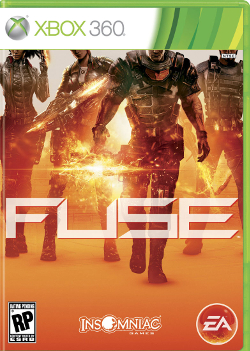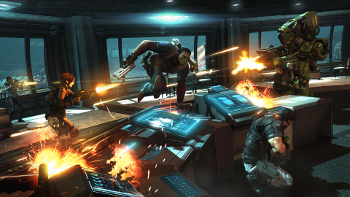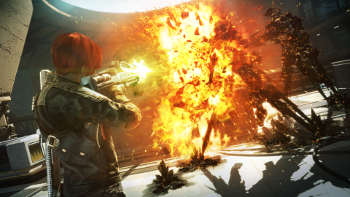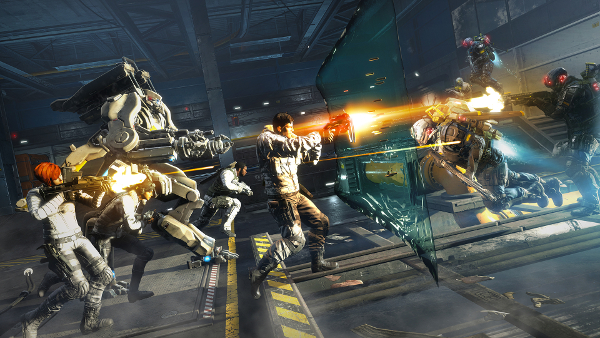BUY IT FROM AMAZON: RIGHT HERE!
PLATFORM: Xbox 360 (Reviewed), Playstation 3
PRICE: $59.99
ESRB RATING: M
DEVELOPER: Insomniac Games
PUBLISHER: EA
In an age where media saturation (or I guess in this case, media media saturation) is the norm, the “pleasant surprise” has become something of a rarity. Video games especially have a tendency to herald the arrival of new titles both early and frequently, from first teaser trailer right through final playable demo, so the low-key release that isn’t indie or foreign usually indicates a game being quietly put out to die. At first glance Fuse sure does seem to fit that bill. The first multi-platform title from developer Insomniac Games (of Ratchet & Clank and Resistance fame), Fuse’s hype certainly doesn’t seem in line with Insomniac’s pedigree. A cross-platform 4 player co-op shooter from the Spyro guys? Where are the banner ads? The commercials? The fanfare?
Fuse tells the story of terrorist organization Raven’s attempts to acquire and utilize the titular alien substance, Unobtanium of the highest order that acts as both a perpetual power source and a WMD. Opposing them is Overstrike 9, a paramilitary organization composed of the world’s most generically kooky mercenaries. You’ve got Dalton, the cynical ex-Raven leader, Jacob, the former cop on the edge, Naya, the former assassin, and Izzy, the other one. Together they travel the globe from secret underground research base, to secret underwater research base, to secret outer space research base, all while trading quips and banter that only occasionally falls below inoffensive cliché.
 It’s a premise so threadbare you can see individual strands, but ultimately would have been blandly serviceable if it wasn’t for the occasional bizarre tonal shifts. One second the group is making fun of Dalton’s fear of cats (a gag that both appears out of and leads absolutely nowhere), the next we get a flashback to him cutting out some guy’s eyes. The space station with a room for corrupted Fuse that’s actually labeled “Corrupted Fuse Command Deck” also has a secret room where some grunt’s committed suicide because his secret evil cabal was a little TOO evil. It would be one thing if the violence was played for laughs ala The Expendables, but the whole thing comes off as a sort of weirdly dour take on G.I. Joe*.
It’s a premise so threadbare you can see individual strands, but ultimately would have been blandly serviceable if it wasn’t for the occasional bizarre tonal shifts. One second the group is making fun of Dalton’s fear of cats (a gag that both appears out of and leads absolutely nowhere), the next we get a flashback to him cutting out some guy’s eyes. The space station with a room for corrupted Fuse that’s actually labeled “Corrupted Fuse Command Deck” also has a secret room where some grunt’s committed suicide because his secret evil cabal was a little TOO evil. It would be one thing if the violence was played for laughs ala The Expendables, but the whole thing comes off as a sort of weirdly dour take on G.I. Joe*.
Thankfully both the characters and their generic terrorist opponents are just trappings around the real stars of the show: the group’s Fuse-powered Xenotech weapons. Insomniac is a developer that knows crazy weaponry, and as the game’s only legitimate selling point these deliver. Each weapon feels distinct, and using them in conjunction with each other not only yields more damage, but higher XP rewards as well. Dalton’s Mag Shield can stop enemy rounds and send out a short-range shockwave, Naya’s Warp Rifle creates chains of mini-black holes on enemies, Izzy’s Shattergun crystalizes enemies into breakable forms, and Jacob’s Arcshot fires flaming bolts. The characters also have the unique secondary abilities of deployable shields, cloaking, med-beacons and igniting arrows respectively. Combined with the Fusion ability which allows for temporary invulnerability and unlimited ammo, and the potential for mayhem is high.
 To the game’s credit all four weapons feel useful, though playing through the campaign initially I tended to gravitate towards Naya and the Warp Rifle, not only because it was the most visually impressive but because her secondary cloak ability was the most useful for solo play. Once I began leveling up the various characters though, I found myself switching more and more often to take advantage of different tactics. For instance, Izzy’s weapon has the weakest damage, but can be used to freeze larger enemies and can fire continuously without reloading. Jacob meanwhile has very limited ammo but high damage, and his secondary ability can be used to disrupt shield-holding enemies. The only semi-dud in the bunch was Dalton. I never found his secondary shield ability particularly useful (in part because I could never position the damn things properly), and the short-range nature of his Mag Shield makes it more effective in co-op, where you can coordinate with other players to cover your flanks. There’s also a variety of secondary weapons, which especially early on feel deliberately underpowered. However, you can upgrade the player’s skills to make them deal more damage, and the shotgun and basic pistol do pack a decent wallop. Normally this would be more of a problem, but with the focus squarely on the primary weapons the secondary stuff essentially acts as a stop-gap for specific scenarios and/or as a way to pick off a few enemies to refill your primary ammo.
To the game’s credit all four weapons feel useful, though playing through the campaign initially I tended to gravitate towards Naya and the Warp Rifle, not only because it was the most visually impressive but because her secondary cloak ability was the most useful for solo play. Once I began leveling up the various characters though, I found myself switching more and more often to take advantage of different tactics. For instance, Izzy’s weapon has the weakest damage, but can be used to freeze larger enemies and can fire continuously without reloading. Jacob meanwhile has very limited ammo but high damage, and his secondary ability can be used to disrupt shield-holding enemies. The only semi-dud in the bunch was Dalton. I never found his secondary shield ability particularly useful (in part because I could never position the damn things properly), and the short-range nature of his Mag Shield makes it more effective in co-op, where you can coordinate with other players to cover your flanks. There’s also a variety of secondary weapons, which especially early on feel deliberately underpowered. However, you can upgrade the player’s skills to make them deal more damage, and the shotgun and basic pistol do pack a decent wallop. Normally this would be more of a problem, but with the focus squarely on the primary weapons the secondary stuff essentially acts as a stop-gap for specific scenarios and/or as a way to pick off a few enemies to refill your primary ammo.
Overall it’s a fun mix, and swapping between members in solo play is quick and seamless, though you can’t transfer when carrying a heavy weapon or downed. The AI meanwhile does a decent job of fending for itself, though there was the occasional bone-headed move like inexplicably falling to their death during one of the game’s limited climbing sections. Granted, the game is more entertaining (and easier) with human companions, but I was still able to finish my entire first campaign run (6 missions spanning roughly 6-8 hours) using only the AI companions. The characters also get noticeably more effective as you level them up, though the upgrade system is surprisingly limited. Outside of a handful of improvements to their individual abilities, the majority of skills are identical amongst the four agents. You can also purchase upgradable team perks for each character, but these tend to be relatively minor bonuses like extra XP and Fuse credits.
 That limited nature extends to other aspects of the game as well. With the exception of some truly awful secondary animations the visuals are generally fine, but neither the graphics nor art design is particularly noteworthy. Outside of the campaign, gameplay is limited to Echelon mode, where players battle waves of enemies in arena maps culled from the campaign. Expect to play a fair amount of this mode if you want to unlock team perks and custom outfits for your characters, as the campaign is downright miserly when it comes to awarding Fuse credits. Speaking of recycling campaign material, those custom outfits (which represent the sole character customization) are mainly just culled from the campaign, and none are particularly impressive. The whole thing reeks of a tight budget stretched to the breaking point.
That limited nature extends to other aspects of the game as well. With the exception of some truly awful secondary animations the visuals are generally fine, but neither the graphics nor art design is particularly noteworthy. Outside of the campaign, gameplay is limited to Echelon mode, where players battle waves of enemies in arena maps culled from the campaign. Expect to play a fair amount of this mode if you want to unlock team perks and custom outfits for your characters, as the campaign is downright miserly when it comes to awarding Fuse credits. Speaking of recycling campaign material, those custom outfits (which represent the sole character customization) are mainly just culled from the campaign, and none are particularly impressive. The whole thing reeks of a tight budget stretched to the breaking point.
For those of you who’ve already snuck a look at the score, you’re probably thinking that’s quite a few critiques for a 3 1/2 out of 5 game. It’s true the game has a lot of limitations, but at the end of a day from a basic, meat-and-potatoes mechanics perspective I can’t deny that the game is fun. A lot of fun. Lighting up a whole row of baddies to set off a chain reaction of black holes, sticking a shield guy with an arrow then igniting his friends, boxing enemies into a corner then pulping them with a shield blast, it’s all incredible satisfying, and the constantly ticking XP counter makes for a cathartic play experience. It’s telling that in a game designed for 4-player co-op, I sunk in numerous hours playing the Echelon maps solo. Granted, the game is more entertaining with a group of communicating players, but this is one of those instances where just the act of killing enemies was satisfying in and of itself. As a reviewer it’s frustrating, because it’s easy to string out a litany of the game’s shortcomings, but the positive aspects come down to a single gimmick and an intangible “it just feels good.” If this were a $20 downloadable title (and at times it feels like a $20 downloadable title), that would be enough for an easy recommendation. As it stands, I’d recommend a demo playthrough and assessment of willing friends before making any purchase.





Out of 5
*-About that tone: I didn’t come across this fact until after I’d sunk a fair amount of time into the game, and it obviously wouldn’t have affected my score one way or the other, but part of the reason I hadn’t heard of Fuse is likely due to the fact that it didn’t start out as Fuse, but rather a similar but seemingly goofier take on the material called Overstrike, the trailer for which you can see below. As the old saying goes, if ifs and buts were candies and nuts, then Duke Nukem Forver probably wouldn’t have sucked so bad. That being said, it’s hard not to watch that trailer and see a possible explanation for the game’s discordant tone, and to wonder what might have been had Insomniac (or if I were a betting man, EA) not decided they needed to add a liberal dash of unnecessary grittiness.
Follow me on Twitter
